Aturás maniocs beijus
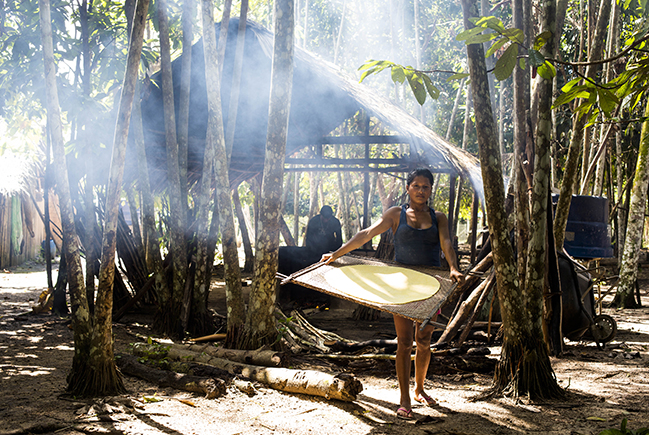
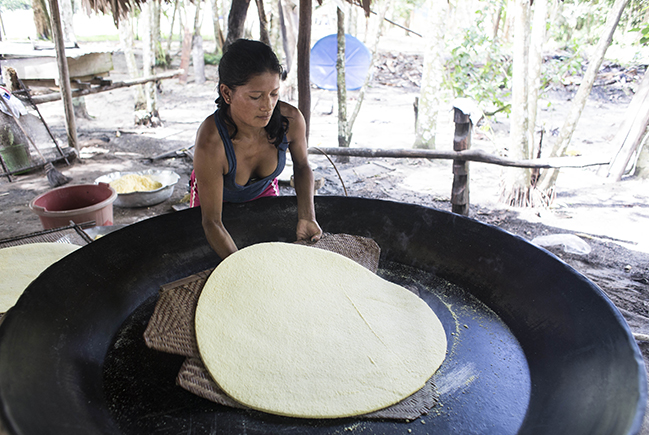

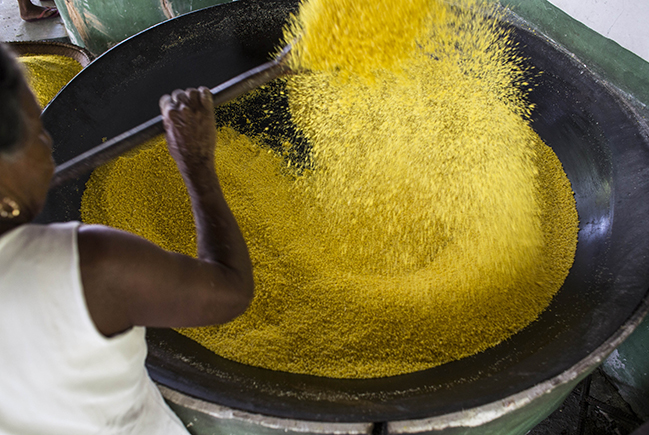
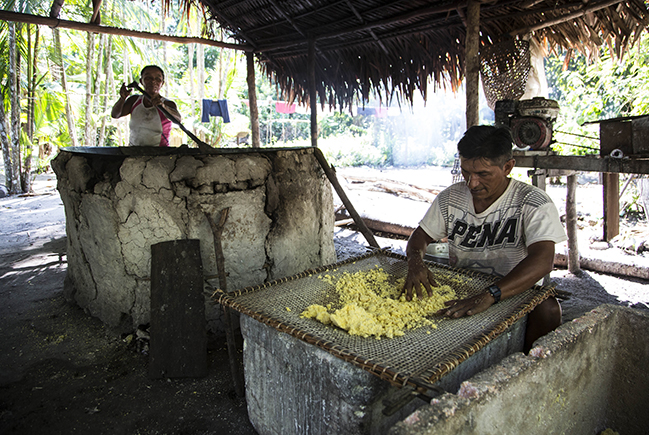
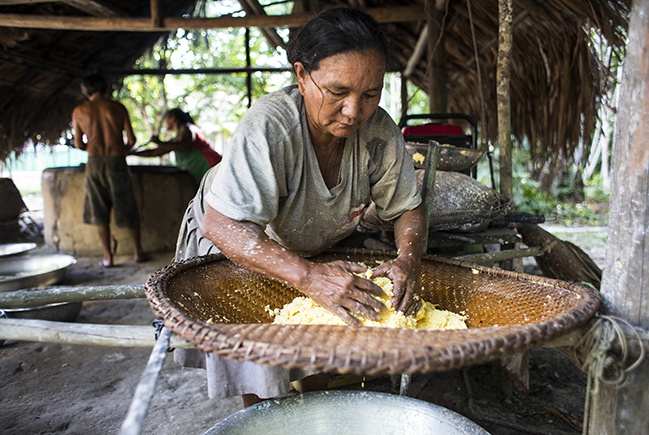
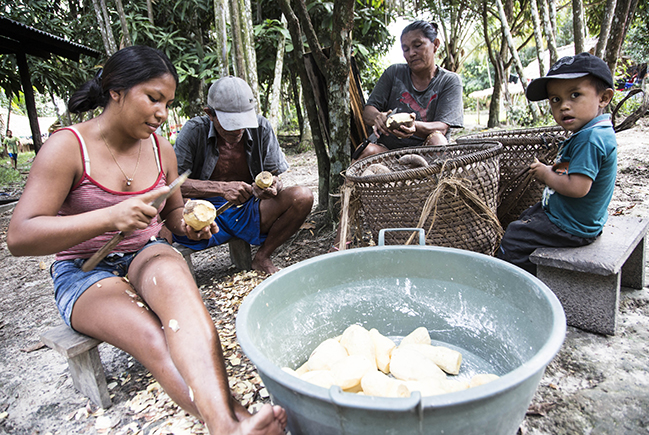
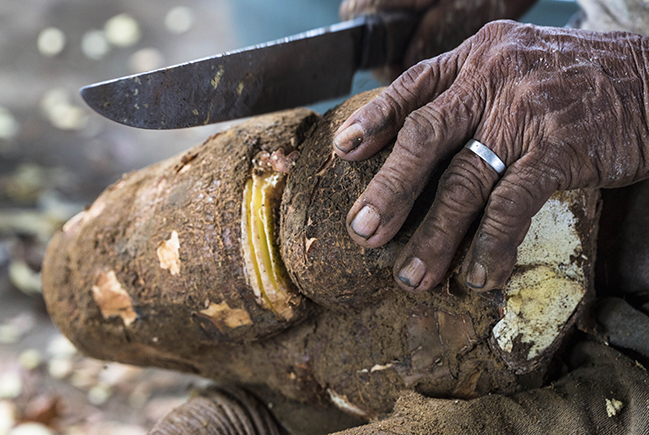
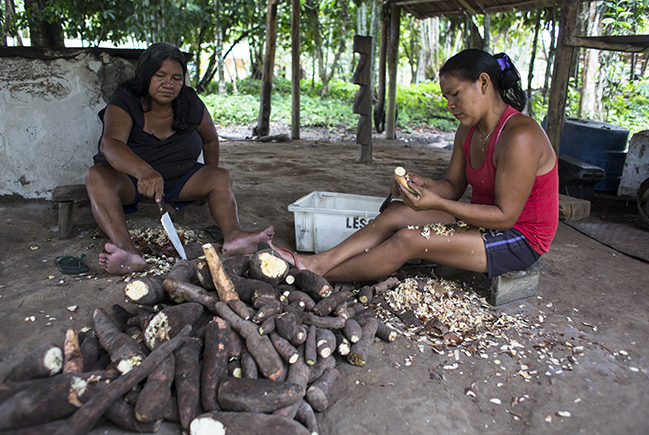
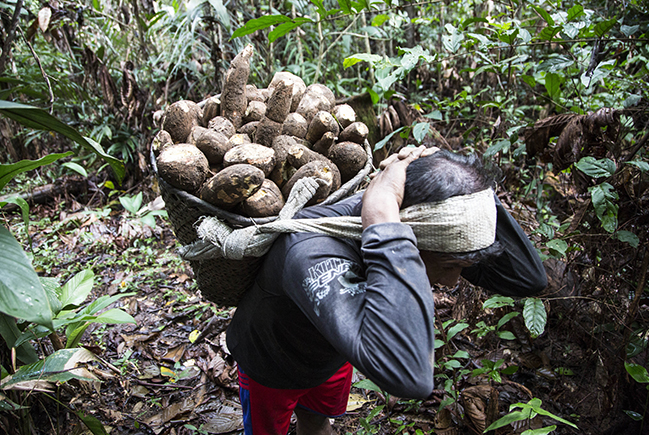
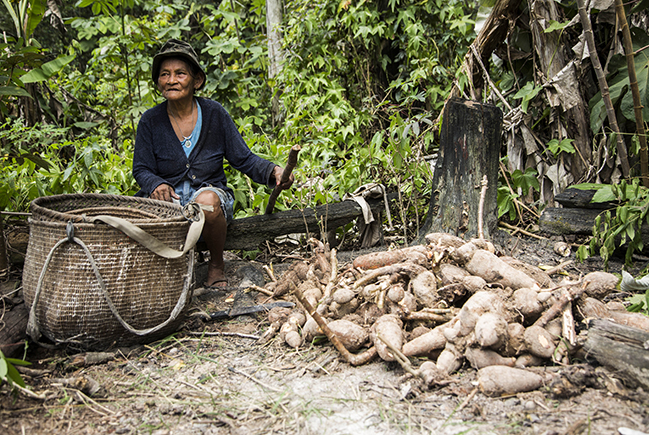
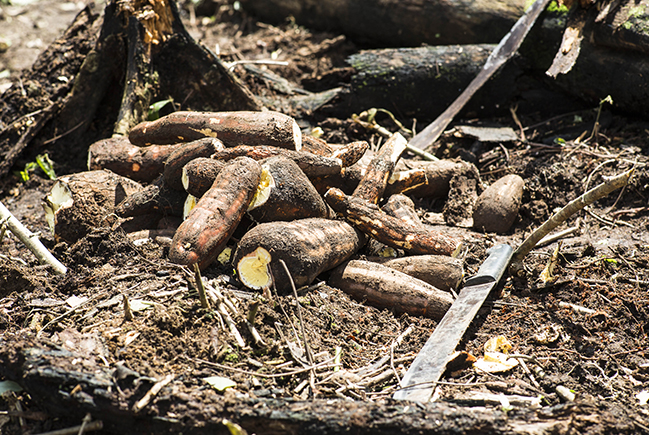
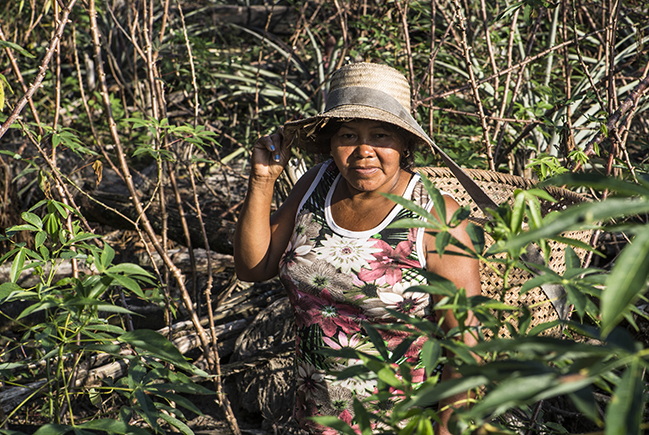
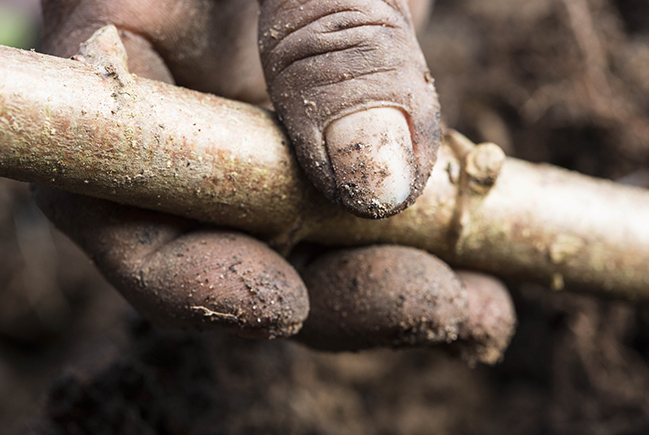
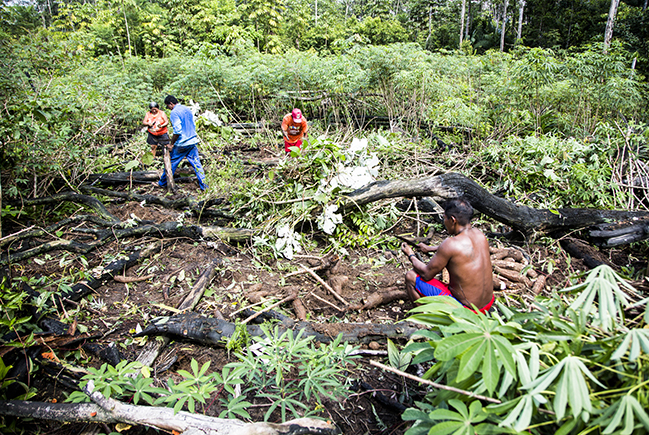
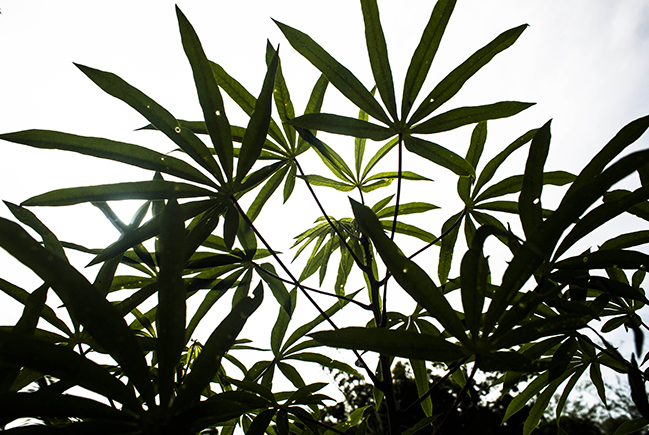
Traditional Agricultural System of the Negro River
Bitter sweet manioc!
Bitter manioc (Manihot esculenta) is toxic. Through an ingenious succession of manipulations – grating the roots, squeezing the pulp, and toasting the flour –, its toxicity can be significantly reduced, and a product that is naturally toxic is transformed into a healthy, nutritious, and tasty food.
Not all cultivated manioc is bitter. There is also the sweet, edible manioc, a species thought to be older than the bitter variety.
Some studies suggest that the Manihot was not originally bitter, and that its cyanate content used to be low. Its toxicity was then gradually incremented by the action of the indigenous farmers who were interested in protecting their crops, habitually devastated by the agoutis that would gnaw and eat – and still do – the tubers buried in the fields.
Both processes reveal ingenious manipulations, arousing the observer’s curiosity: how was it possible to imagine that a tuber could be subjected to manipulations that would render it proper or improper for consumption by human beings or agoutis?
Can you imagine transforming the curare (Strychnos toxifera) – used in academic medicine and on arrowheads as a powerful muscle contraction inhibitor – into a tasty food seasoning? Imagine a plate of “curare rice,” prepared in like fashion as rice with jambu (Acmella oleracea), which has a slight numbing effect on the lips.
“Tamed” manioc, originating in the Amazon, has always played and continues to play a very important dietary role for the peoples of Central and South America, like that of wheat in Europe.
The Aturás Maniocs Beijus exhibition celebrates the Traditional Agricultural System of the Negro River, a region that has in the manioc its queen, and where the cultivation of manioc in fields shared with other edible plants has prospered and diversified through successive manipulations.
In the Santa Isabel do Rio Negro fields, this crossbreeding originated over 200 manioc varieties with different maturation and cooking times, textures, toxicity, and flavors – a significant number if we take into account that there are about two thousand known manioc varieties all over the world today.
In addition to South and Central America, where studies show that the manioc was originated, it is cultivated in large scale in India, Africa, Thailand, and Vietnam.
To what do we owe this great diversity in the Negro River region, particularly in Santa Isabel? A plausible answer was given by research conducted by anthropologist Janet Chernela in the area in the 1980s. These studies were resumed at the end of the 1990s by Manuela Carneiro da Cunha, Lucia van Velthem, and Laure Emperaire, who inspired this exhibition.
Chernela and Emperaire attributed the astounding number of varieties to the intense circulation of manioc cuttings and seeds among different fields in the region, a process enabled in large part by the norms that rule or used to rule marriages. According to tradition, they must take place between young people from different ethnicities and languages, which likely intensified the exchange and transportation of manioc cuttings and seeds, “dowries” that always come along with the brides.
This norm has prevailed in the cultural traditions of numerous ethnicities in the Negro River, a region that, to this day, is home to over 20 ethnicities speaking about 15 indigenous languages.
Crossbreeding maniocs and producing new varieties is important because it not only allows farmers to harvest manioc at different times of the year, but also assures that, if a variety is devastated by a plague, other resistant ones will preserve the plant’s genetic features.
The Traditional Agricultural System of the Negro River – registered by IPHAN as intangible cultural heritage and celebrated by the exhibition Aturás Maniocs Beijus – deals with the cultivation of manioc and other edible crops planted alongside it, revealing the secrets behind the preparation of the soil, the production of flour, and its use to prepare flavorful beijus and beijus cicas. It also suggests how to separate a variety from another by flavor, texture, and smell – sensitive qualities that might be absent from the botanical taxonomy, but that are always present in day to day life in the fields.
There are other surprises for the visitors who attends the exhibition: they also discover that burning trees to prepare the field – the “coivara” ritual – is done because the ashes improve the fertility of the soil, while the fallen branches and trunks provide shade that protects the germinating seeds and cuttings from the hot sun. Visitors can see and touch the midribs of palms and vines that are rigorously braided with rhythm and symmetry to make aturás, cargo baskets, sieves, tipitis, and straw fans, artifacts that have an age-old history.
In the flour house, set up at the Musa exhibition, we find the oven, the grater, the press, sieves, straw fans, and the ingenious tipiti: a cylinder made of arumã strips interwoven into a large circular mesh. When stretched, the tipiti squeezes the still wet manioc pulp, recently grated on a grater that only the Baniwa from the Santa Isabel region can “make well.”
There are also political reasons that justify the exhibition. When the ACIMRN (Associação das Comunidades Indígenas do Médio Rio Negro) and the FOIRN (Federação das Organizações Indígenas do Rio Negro) requested in 2011 that the Traditional Agricultural System of the Negro River be registered as intangible cultural heritage, the indigenous farmers thought that they should record their techniques, their knowledge, and the manifestation of their traditional culture, preserved for hundreds or thousands of years.
This concrete knowledge has allowed the peoples in the region to provide their own food and to live and grow successfully, while telling through myths and legends the story of their origin and life in the forest – their own and that of the manioc, as described in the exquisite watercolors by Desana artist Feliciano Lana.
This knowledge of the land as well as of the traditional planting and “taming” techniques and tools contains secrets that must be passed onto the younger generation and exhibited in culture houses and living museums, where collected items may mobilize all the five senses, recounting the knowledge and the feelings of the peoples who live there – peoples who, having occupied these lands since ancient times, have defined the territories where they put down their roots. It was there that they learned how to plant, harvest, and transform bitter and sweet maniocs.
Today, the demarcation of indigenous lands is a constitutional right expressed in the Constitution of 1988, but which, after 30 years, has not yet been concluded. There are still lots of lands to be demarcated.
By recovering the memory, gathering knowledge testimonies, and telling everyone the history of the manioc, Musa intends to contribute towards the acknowledgment and the respect of the indigenous peoples’ right to the demarcation of their lands.
The Aturás Maniocs Beijus exhibit was planned and set up with these goals. Many minds and arms have participated in its conception: Carlos Nery, Sandra Gomes Castro, Cecilia Braga da Silva, Adilson da Silva Joanico, and Ilma Fernandes Nery sign the participative curatorship along with Lucia van Velthem. Regina Ferraz designed it, and Juan Gabriel Soler Alarcón recorded the interviews, images, and movement.
We would also like to thank Bemol and Fogás for largely financing this exhibition through the Rouanet-MinC Law, and the Universidade do Estado do Amazonas (UEA) for its support.
